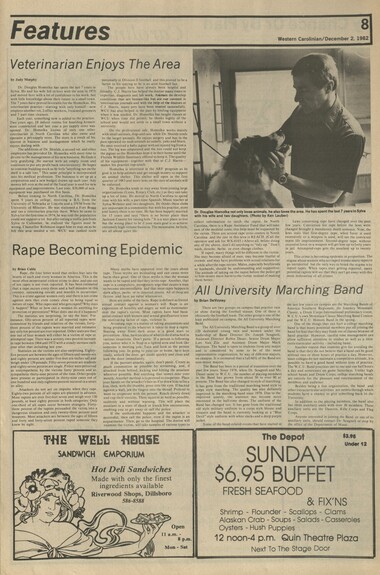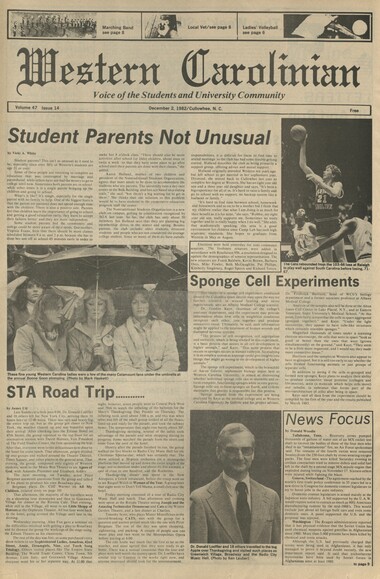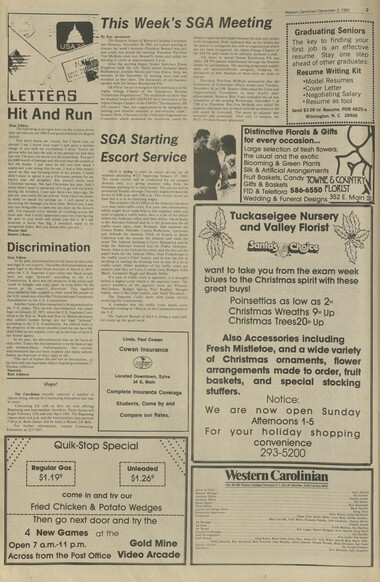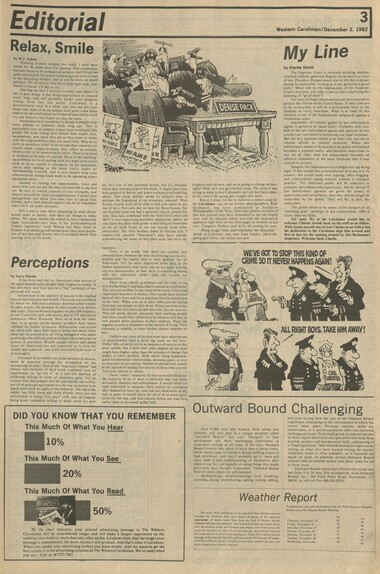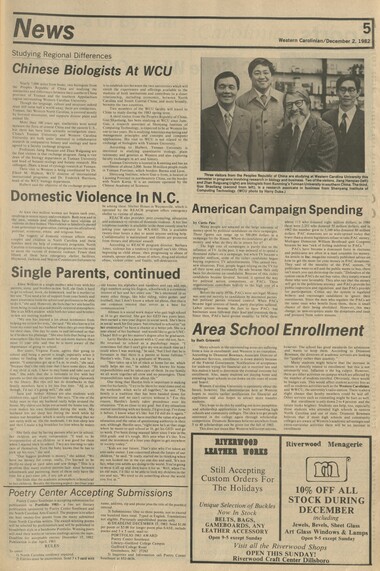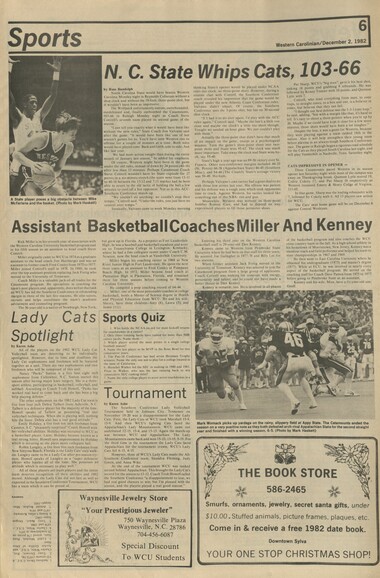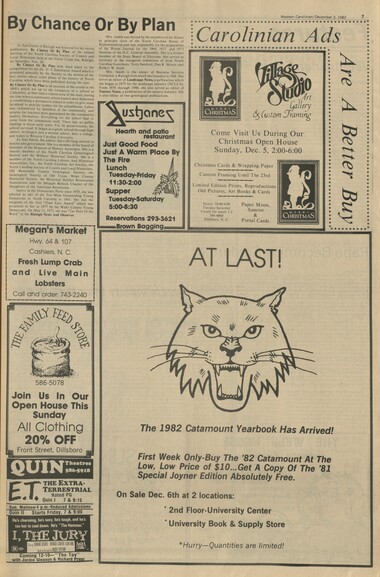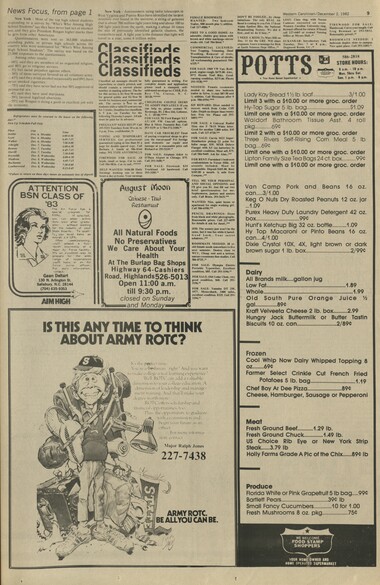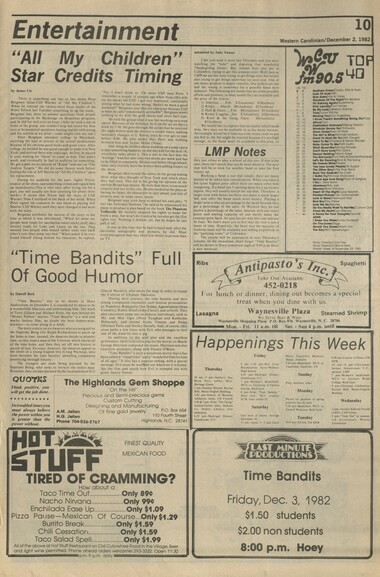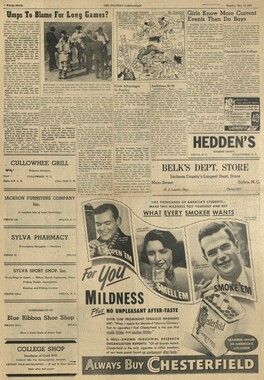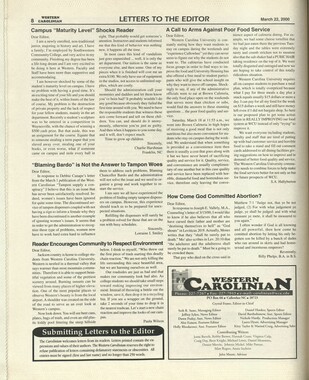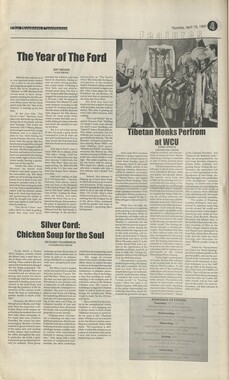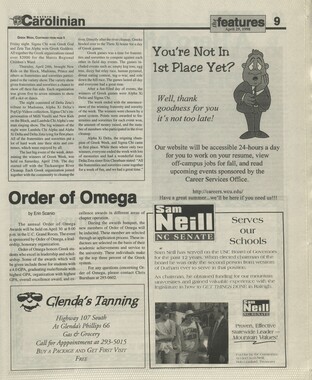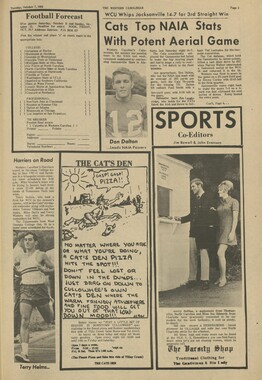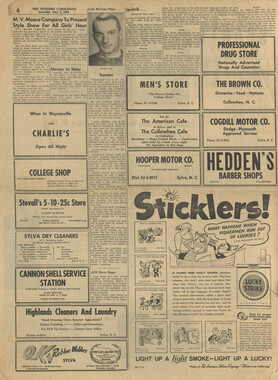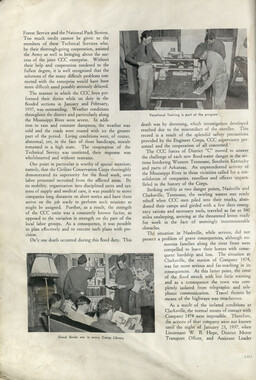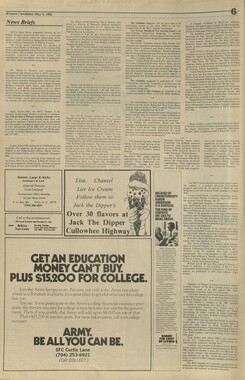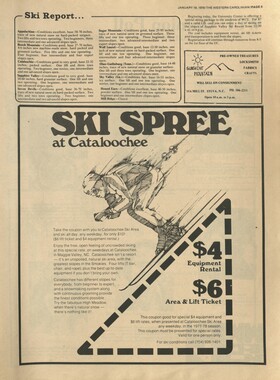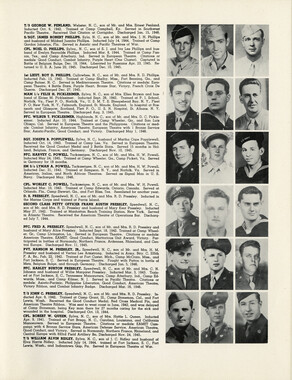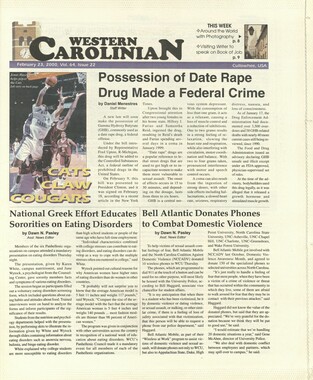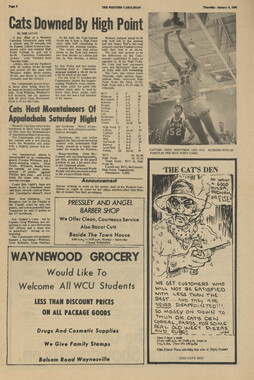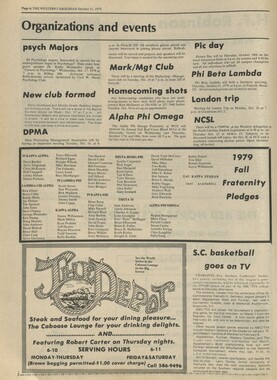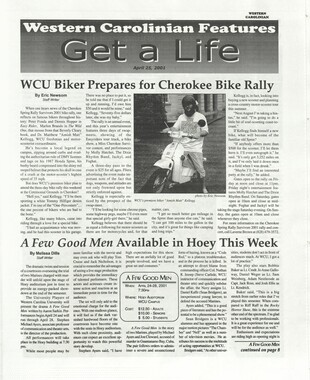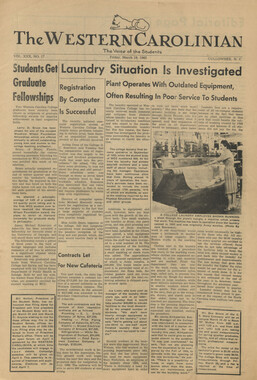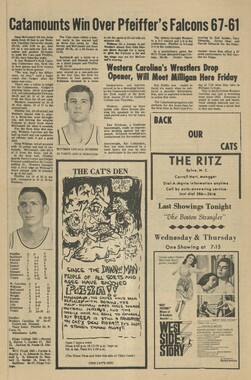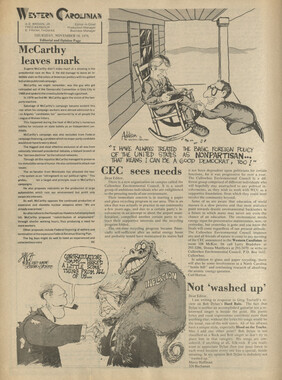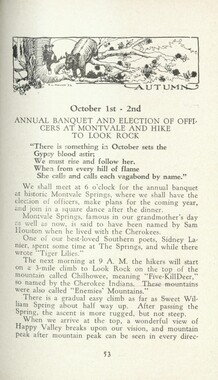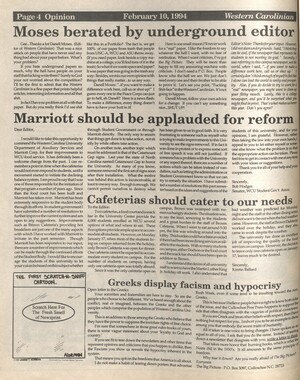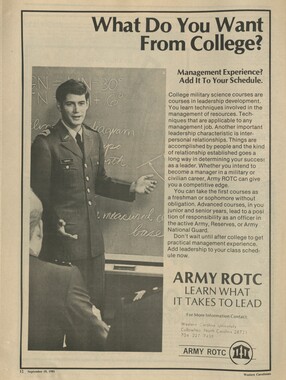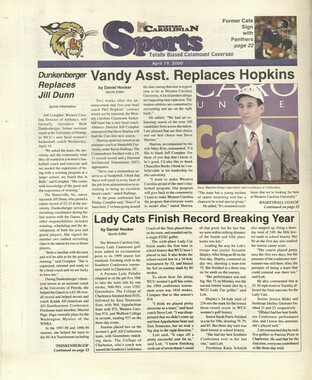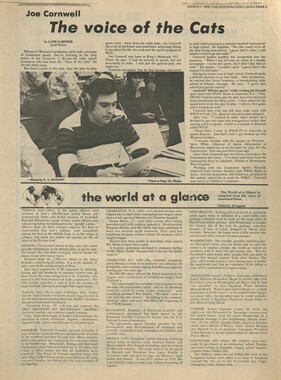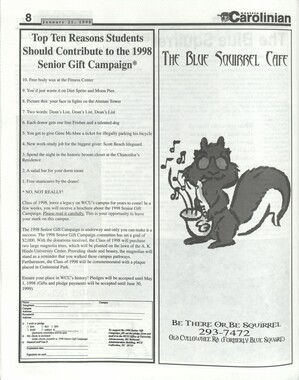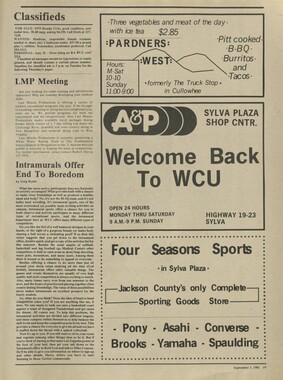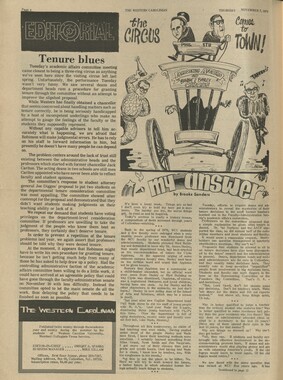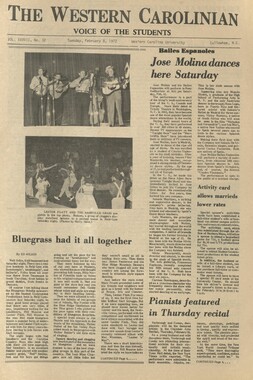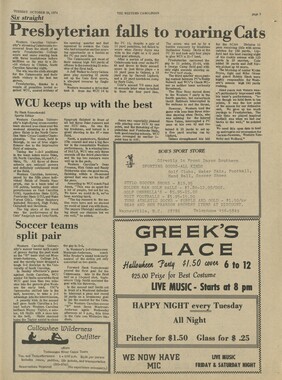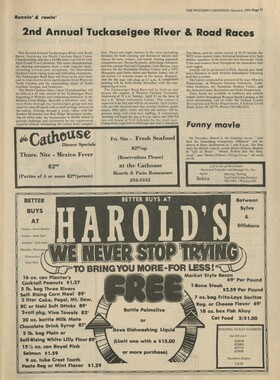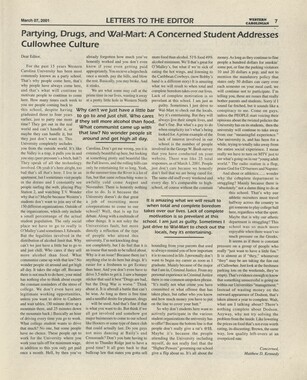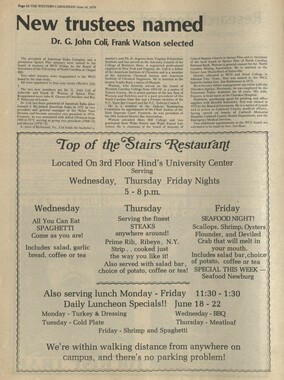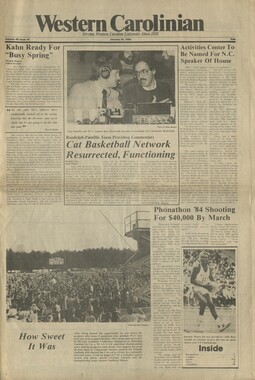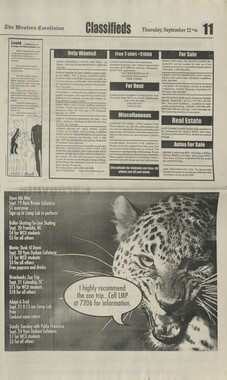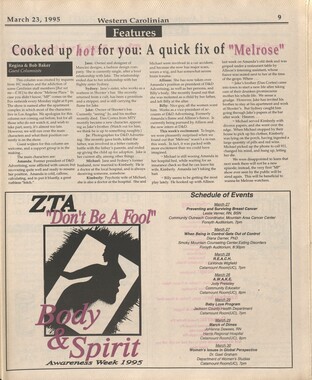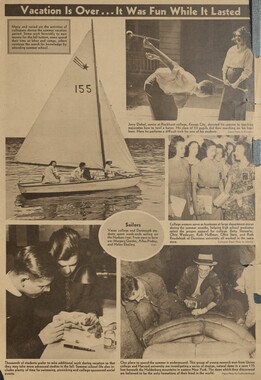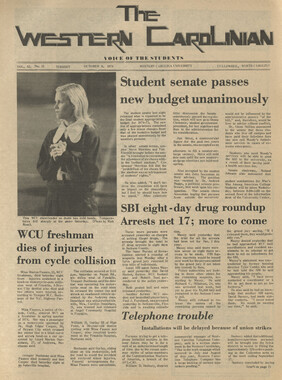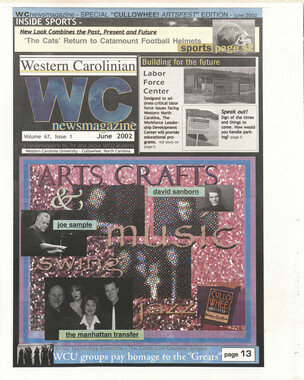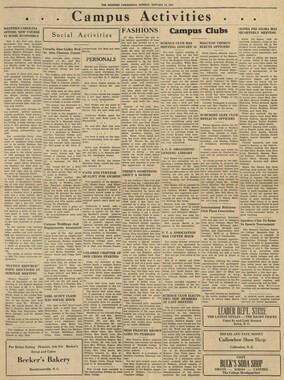Western Carolina University (20)
View all
- Canton Champion Fibre Company (2308)
- Cherokee Traditions (292)
- Civil War in Southern Appalachia (165)
- Craft Revival (1942)
- Great Smoky Mountains - A Park for America (2766)
- Highlights from Western Carolina University (430)
- Horace Kephart (941)
- Journeys Through Jackson (154)
- LGBTQIA+ Archive of Jackson County (85)
- Oral Histories of Western North Carolina (314)
- Picturing Appalachia (6772)
- Stories of Mountain Folk (413)
- Travel Western North Carolina (160)
- Western Carolina University Fine Art Museum Vitreograph Collection (129)
- Western Carolina University Herbarium (92)
- Western Carolina University: Making Memories (708)
- Western Carolina University Publications (2283)
- Western Carolina University Restricted Electronic Theses and Dissertations (146)
- Western North Carolina Regional Maps (71)
- World War II in Southern Appalachia (131)
University of North Carolina Asheville (6)
View all
- Allanstand Cottage Industries (62)
- Appalachian National Park Association (53)
- Bennett, Kelly, 1890-1974 (1388)
- Berry, Walter (76)
- Brasstown Carvers (40)
- Carver, George Washington, 1864?-1943 (26)
- Cathey, Joseph, 1803-1874 (1)
- Champion Fibre Company (233)
- Champion Paper and Fibre Company (297)
- Cherokee Indian Fair Association (16)
- Cherokee Language Program (22)
- Crowe, Amanda (40)
- Edmonston, Thomas Benton, 1842-1907 (7)
- Ensley, A. L. (Abraham Lincoln), 1865-1948 (275)
- Fromer, Irving Rhodes, 1913-1994 (70)
- George Butz (BFS 1907) (46)
- Goodrich, Frances Louisa (120)
- Grant, George Alexander, 1891-1964 (96)
- Heard, Marian Gladys (60)
- Kephart, Calvin, 1883-1969 (15)
- Kephart, Horace, 1862-1931 (313)
- Kephart, Laura, 1862-1954 (39)
- Laney, Gideon Thomas, 1889-1976 (439)
- Masa, George, 1881-1933 (61)
- McElhinney, William Julian, 1896-1953 (44)
- Niggli, Josephina, 1910-1983 (10)
- North Carolina Park Commission (105)
- Osborne, Kezia Stradley (9)
- Owens, Samuel Robert, 1918-1995 (11)
- Penland Weavers and Potters (36)
- Roberts, Vivienne (15)
- Roth, Albert, 1890-1974 (142)
- Schenck, Carl Alwin, 1868-1955 (1)
- Sherrill's Photography Studio (2565)
- Southern Highland Handicraft Guild (127)
- Southern Highlanders, Inc. (71)
- Stalcup, Jesse Bryson (46)
- Stearns, I. K. (213)
- Thompson, James Edward, 1880-1976 (226)
- United States. Indian Arts and Crafts Board (130)
- USFS (683)
- Vance, Zebulon Baird, 1830-1894 (1)
- Weaver, Zebulon, 1872-1948 (58)
- Western Carolina College (230)
- Western Carolina Teachers College (282)
- Western Carolina University (1794)
- Western Carolina University. Mountain Heritage Center (18)
- Whitman, Walt, 1819-1892 (10)
- Wilburn, Hiram Coleman, 1880-1967 (73)
- Williams, Isadora (3)
- Cain, Doreyl Ammons (0)
- Crittenden, Lorraine (0)
- Rhodes, Judy (0)
- Smith, Edward Clark (0)
- Appalachian Region, Southern (2569)
- Asheville (N.C.) (1923)
- Avery County (N.C.) (26)
- Blount County (Tenn.) (161)
- Buncombe County (N.C.) (1672)
- Cherokee County (N.C.) (283)
- Clay County (N.C.) (555)
- Graham County (N.C.) (233)
- Great Smoky Mountains National Park (N.C. and Tenn.) (519)
- Haywood County (N.C.) (3524)
- Henderson County (N.C.) (70)
- Jackson County (N.C.) (4694)
- Knox County (Tenn.) (25)
- Knoxville (Tenn.) (12)
- Lake Santeetlah (N.C.) (10)
- Macon County (N.C.) (420)
- Madison County (N.C.) (212)
- McDowell County (N.C.) (39)
- Mitchell County (N.C.) (132)
- Polk County (N.C.) (35)
- Qualla Boundary (981)
- Rutherford County (N.C.) (76)
- Swain County (N.C.) (2115)
- Transylvania County (N.C.) (270)
- Watauga County (N.C.) (12)
- Waynesville (N.C.) (84)
- Yancey County (N.C.) (72)
- Aerial Photographs (3)
- Aerial Views (60)
- Albums (books) (4)
- Articles (1)
- Artifacts (object Genre) (228)
- Bibliographies (1)
- Biography (general Genre) (2)
- Cards (information Artifacts) (38)
- Clippings (information Artifacts) (191)
- Crafts (art Genres) (622)
- Depictions (visual Works) (21)
- Design Drawings (1)
- Drawings (visual Works) (184)
- Envelopes (73)
- Facsimiles (reproductions) (1)
- Fiction (general Genre) (4)
- Financial Records (12)
- Fliers (printed Matter) (67)
- Glass Plate Negatives (381)
- Guidebooks (2)
- Internegatives (10)
- Interviews (815)
- Land Surveys (102)
- Letters (correspondence) (1013)
- Manuscripts (documents) (618)
- Maps (documents) (177)
- Memorandums (25)
- Minutes (administrative Records) (59)
- Negatives (photographs) (5835)
- Newsletters (1285)
- Newspapers (2)
- Occupation Currency (1)
- Paintings (visual Works) (1)
- Pen And Ink Drawings (1)
- Periodicals (193)
- Personal Narratives (10)
- Photographs (12976)
- Plans (maps) (1)
- Poetry (6)
- Portraits (4533)
- Postcards (329)
- Programs (documents) (151)
- Publications (documents) (2236)
- Questionnaires (65)
- Scrapbooks (282)
- Sheet Music (2)
- Slides (photographs) (402)
- Songs (musical Compositions) (2)
- Sound Recordings (796)
- Specimens (92)
- Speeches (documents) (15)
- Tintypes (photographs) (8)
- Transcripts (322)
- Video Recordings (physical Artifacts) (23)
- Vitreographs (129)
- Text Messages (0)
- A.L. Ensley Collection (275)
- Appalachian Industrial School Records (7)
- Appalachian National Park Association Records (336)
- Axley-Meroney Collection (2)
- Bayard Wootten Photograph Collection (20)
- Bethel Rural Community Organization Collection (7)
- Blumer Collection (5)
- C.W. Slagle Collection (20)
- Canton Area Historical Museum (2110)
- Carlos C. Campbell Collection (282)
- Cataloochee History Project (64)
- Cherokee Studies Collection (4)
- Daisy Dame Photograph Album (5)
- Daniel Boone VI Collection (1)
- Doris Ulmann Photograph Collection (112)
- Elizabeth H. Lasley Collection (1)
- Elizabeth Woolworth Szold Fleharty Collection (4)
- Frank Fry Collection (95)
- George Masa Collection (173)
- Gideon Laney Collection (452)
- Hazel Scarborough Collection (2)
- Hiram C. Wilburn Papers (28)
- Historic Photographs Collection (236)
- Horace Kephart Collection (861)
- Humbard Collection (33)
- Hunter and Weaver Families Collection (1)
- I. D. Blumenthal Collection (4)
- Isadora Williams Collection (4)
- Jesse Bryson Stalcup Collection (47)
- Jim Thompson Collection (224)
- John B. Battle Collection (7)
- John C. Campbell Folk School Records (80)
- John Parris Collection (6)
- Judaculla Rock project (2)
- Kelly Bennett Collection (1407)
- Love Family Papers (11)
- Major Wiley Parris Civil War Letters (3)
- Map Collection (12)
- McFee-Misemer Civil War Letters (34)
- Mountain Heritage Center Collection (4)
- Norburn - Robertson - Thomson Families Collection (44)
- Pauline Hood Collection (7)
- Pre-Guild Collection (2)
- Qualla Arts and Crafts Mutual Collection (12)
- R.A. Romanes Collection (681)
- Rosser H. Taylor Collection (1)
- Samuel Robert Owens Collection (94)
- Sara Madison Collection (144)
- Sherrill Studio Photo Collection (2558)
- Smoky Mountains Hiking Club Collection (616)
- Stories of Mountain Folk - Radio Programs (374)
- The Reporter, Western Carolina University (510)
- Venoy and Elizabeth Reed Collection (16)
- WCU Gender and Sexuality Oral History Project (32)
- WCU Mountain Heritage Center Oral Histories (25)
- WCU Oral History Collection - Mountain People, Mountain Lives (71)
- WCU Students Newspapers Collection (1744)
- Western North Carolina Tomorrow Black Oral History Project (69)
- William Williams Stringfield Collection (2)
- Zebulon Weaver Collection (109)
- African Americans (390)
- Appalachian Trail (35)
- Artisans (521)
- Cherokee art (84)
- Cherokee artists -- North Carolina (10)
- Cherokee language (21)
- Cherokee pottery (101)
- Cherokee women (208)
- Church buildings (170)
- Civilian Conservation Corps (U.S.) (110)
- College student newspapers and periodicals (1830)
- Dams (107)
- Dance (1023)
- Education (222)
- Floods (61)
- Folk music (1015)
- Forced removal, 1813-1903 (2)
- Forest conservation (220)
- Forests and forestry (1184)
- Gender nonconformity (4)
- Great Smoky Mountains National Park (N.C. and Tenn.) (181)
- Hunting (38)
- Landscape photography (25)
- Logging (118)
- Maps (83)
- Mines and mineral resources (8)
- North Carolina -- Maps (18)
- Paper industry (38)
- Postcards (255)
- Pottery (135)
- Railroad trains (71)
- Rural electrification -- North Carolina, Western (3)
- School integration -- Southern States (2)
- Segregation -- North Carolina, Western (5)
- Slavery (5)
- Sports (452)
- Storytelling (244)
- Waterfalls -- Great Smoky Mountains (N.C. and Tenn.) (66)
- Weaving -- Appalachian Region, Southern (280)
- Wood-carving -- Appalachian Region, Southern (328)
- World War, 1939-1945 (173)
Western Carolinia Volume 47 Number 14
Item
Item’s are ‘child’ level descriptions to ‘parent’ objects, (e.g. one page of a whole book).
-
-
Features 3 Western Carolinian/December 2. 1982 Veterinarian Enjoys The Area by Judy Murphy Dr. Douglas Homolka has spent the last 7 years in Svlva. He and his wife fell in love with the area in 1975 and moved here with a lot of confidence in his work but with little knowledge about their future in a small town. The 7 years have proved favorable for the Homolkas. His veterinarian practice starting with only himself now employs another vet, 2 office workers, 3 trained groomers and 3 part time cleaners. Each year, something new is added to the practice. I wo years ago, 18 indoor rooms for boarding kennels were constructed and last year a pet supply store was opened. Dr. Homolka knows of only one other veterinarian in North Carolina who also owns and operates a pet-supply store. The store is a result of his interest in business and management which he really enjoys dealing with. The additions of Dr. Shields, a second vet and other employees has provided Dr. Homolka with more time to devote to the management of his new business. He finds it very gratifying. He started with an empty room and continues to put any profit back into inventory. He hopes to continue building stock as he feels "anything not on the shelf is a sale lost." This same principle is incorporated into his medical profession. The business is set up as a corporation and a new budget drawn up each year. Any money left over at the end of the fiscal year is used for new equipment and improvements. Last year, $10,000 of new equipment was purchased on this basis. Before coming to North Carolina, Dr. Homolka spent 9 years in college, receiving a B.S. from the University of Nebraska at Lincoln and a DVM from the University of Missouri. He was stationed a Fort Bragg and ran a veterinarian practice there. When he came to Sylva for the first time in 1974, he was told the population could not support a vet but after seeing a traffic jam from Sylva to Cullowhee, he realized the figures must be wrong. Chancellor Robinson urged him to stay on as he felt this area needed a vet. WCU was ranked sixth nationally in Division 11 football and this proved to be a factor in his staying as he is an avid football fan. The people here have always been helpful and friendly. C.J Harris has helped the doctor many times in expertise, diagnosis and lab work. Animals do develop conditions that are human-like but are not covered in veterinarian journals and with the help of the doctors at C.J. Harris, many pets have been treated successfully. WCU has also helped in the past by lending equipment when it wa.s needed. Dr. Homolka has taught classes at WCU when time did permit; he thinks highly of the school and would not settle in a small town without a university. On the professional side, Homolka works mainly with small animals, dogs and cats while Dr. Shields tends to the larger animals. He enjoys surgery and has in the past operated on such animals as camels, yaks and bears. He once received a baby jaguar with an injured legfroma zoo. The leg was amputated and the zoo could not keep the jaguar so the Homolkas kept it in their home until the Florida Wildlife Sanctuary offered to keep it. The quality of his equipment- together with that at C.J. Harris— makes his practice top-notch. Homolka is interested in the ARF program as its goal is to help animals and get enough money to support an animal shelter. This shelter will open in the first quarter of 1983 and more laws on the care of animals will be enforced. Dr. Homolka tends to stay away fromjoining large organizations (Lions, Rotary Club, etc.) as they can take Up a lot of time. He moved to North Carolina to spend time with his wife, a part-time Spanish/ Music teacher at Sylva-Webster and two daughters. He thinks these clubs are important in a community but with his practice, store and family there is no time. He has been happily married for 13 years and says "there is no better place than Jackson County for raising kids." lt is a nice place to live but the wrong place to be if your main goal is to achieve extremely high volume business. The mountains, he feels, are all about quiet life. Rape Becoming Epidemic by Brian Cable Rape, the four letter word that strikes fear into the hearts of each and every woman in America. This is the most often perpetrated violent crime to date and one out of ten rapes is not even reported. It has been estimated that a rape occurs every three and a half minutes in this country, outranking suicide and murder in occurrence. This is a crime against women only and there is not crime against men that even comes close to being equal to nature of rape. Who rapes and who gets raped? Why does it happen? What or how can a woman do anything for protecton or prevention? What does one do if it happens? The statistics are surprising, to say the least. For instance, fifty-seven percent of all reported, rapes were committed by friends and relatives of the victims, forty- three percent of the rapists were married and estimates say only ten percent are ever reported. Other stats are that one out of four women will either be a victim of rape or attempted rape. There was a seventy-two percent increase in rape between 1964 anti 1972 with a steady increase each year after that including last year. Statistics on the victims are also surprising. Eighty- five percent are between the ages of fifteen and twenty-six and eighty percent are under five-feet six-inches tall and weigh under 139 pounds. Fifty-seven percent are students and eighty-seven percent are single. Police were perceived as unsympathetic by the victims forty percent and as sympathetic thirty-nine percent of the time. Other people were present or participated in thirty-nine cases out of one hundred and only eighteen percent occured in a street or alley. Attackers do not act on impulse when they rape. Eighty-two percent of all rapes are planned in advance. Most rapists are over five-feet seven and weigh over 130 pounds, at least eighty percent in both categories. Only one-third of all rapes occur between strangers. Forty- three percent of the rapists persuaded the victim into a dangerous situation and only twenty-three percent used weapons. Most attackers are between the ages of fifteen and forty and forty-seven percent raped someone they knew by sight. Many myths have appeared over the years about rape. These myths are misleading and can cause more harm than good. One of these myths is that the woman wants to be raped and that they invite rape. Another, that rape is a compulsive, momentary urge that causes a man to become uncontrollable and that most rapes happen in dark alleys, parks or in deserted streets. All of these are fiction and have no value whatsoever. Here are some of the facts. Rape is defined as forced sexual contact against a woman's will. Rape is an expression of hostility and anger, as well as dominance over the rapist's victim. Most rapists have had basic social contact with women and sexual gratification is not the motivating factor of rape, violence is. Avoiding rape is a matter of taking precautions and being prepared to do whatever it takes to stop a rapist. Staying away from dark areas is a good start to prevention. Also, have an idea of what to do if attacked in various situations. Don't panic. If a person is following you, notice who it is. Stop in a lighted area and look like someone is meeting you. Turn and look at the person following you. In going to your car or home, have keys ready, unlock the door, get inside quickly and close and lock the door immediately. If the pursuer attacks, again, don't panic. Create as much commotion as possible by screaming, and, if attacked from behind, kicking and hitting the assailant wherever possible. Bite anything that comes near your mouth. Another method is to pretend to cooperate. Place your hands on the attacker's face as if to draw him in for a kiss, then, with the thumbs, press into the eyes. If backed against a wall, jab the fingers into the throat. Pretend to want to cooperate with the person. Reach slowly down and cup their testicles. Then, squeeze as hard as possible, suddenly and without warning. This will place the assailant in a state of shock or knock him unconscious, enabling you to get away or call the police. If the unthinkable happens and the attacker is successful, then call the police, even if the rapist is an acquaintance. Then, go to the hospital. The doctor will examine the victim, will take samples of various types to THE WELL HOUSE SANDWICH CMPORIUM Hot Deli Sandwiches Made with only the finest ingredients available Riverwood Shops, Dillsboro 586-8588 Open 11 a.m. - 8 p.m. Mon - Sat Dr. Douglas Homolka not only loves animals, he also loves the area. He has spent the last 7 years in Sylva with his wife and two daughters. (Photo by Ken Lauber) collect information to catch the rapist. In North Carolina, there is a Rape Assistance Fund that will take care of the medic'al costs; this help must be requested by the victim. There are several rape crisis centers in North Carolina and the one in this area is REACH. (Call the operator and ask for WX-6103.) Above all, before doing any of the above, don't do anything to "tidy up." Don't wash, douche, bathe or even change clothes. If raped, many things will be different to the victim. She may become afraid of men, may become fearful of crowds and may have problems with sexual relations for a while after the rape occurs. Males, especially boyfriends or husbands, should be understanding and supportive. The attitude of taking on the rapist before the police get to him causes more harm to the victim instead of making them better. Laws concerning rape have changed over the past few years. Conviction for rape before the laws were changed brought a mandatory death sentence. Now, the laws state that first-degree rape, when force is used excessively or a weapon is used, will net the convicted rapist life imprisonment. Second-degree rape, without excessive force or a weapon will get him up to forty years in jail. Attempted-rape gets the assailant up to twenty years. This crime is becoming epidemic in proportion. The stigma about women who are raped dooms many rapes to go unreported but the only way to break the stigma is to report rapes. When rapes start getting reported, many potential rapists will see that they can't get away with this most demeaning of all crimes. All University Marching Band by Brian DeVinney There are two groups on campus that practice rain or shine during the football season. One of these is obviously the football team. The other group is one of the least publicized on campus, the All University Marching Band. The All U niversity Marching Band is a group of over 120 dedicated young men and women under the leadership of Band Director Dr. Joseph Scagnoli, Assistant Director Robin Dauer, Senior Drum Major Lori Van Zile and Assistant Drum Major Mark Harrison. The band is open to students from any major and is considered by some to be of the most representative organization, by way of different majors, on campus. It is estimated that a full 60% of the Band are non-music majors. The Band has been in a period of transition over the past few years. Since 1978, when Dr. Scagnoli and Mr. Dauer came to W.C.U., the number of playing members in the Band has grown from about 50 to over 90 at present. The Band has also changed itsstyle of marching. It has gone from the traditional marching band style to corps style marching. The quality has also definitely improved in the marching band since 1978. Due to the improved quality, the audience has become more interested in the half-time shows. The uniform of the Band has changed too. It has gone from the traditional old style military uniform to a corps style blouse and trousers and the band is currently looking at a "Blue Devil" style uniform with white slacks and a deep purple jacket. Some of the band-related events that have started in the last few years on campus are the Marching Bands of America Southern Regionals, the Smokey Mountain Classic, a Drum Corps International preliminary event, W.C.U.'s own Mountain Classic Marching Band Contest and the W.C.U. Honors Band in the spring. One of the things that can hurt a college marching band is that many potential members put off joining the band for fear that they may flunk out of classes because of band practice. However, careful time management can allow sufficient attention to studies as well as a little extra-curricular activity - including band. Another reason that students give for avoiding the band is that they do not believe that a band can be good without two or three hours of practice a day. However, since colleges do not maintain a competitive attitude, it is possible to have a good band without tons of practice. The W.C.U. Band practices one to one and one half hours a day and sometimes on game Saturdays. Unlike high school bands and Drum Corps, college marching bands are entirely for the pleasure and entertainment of the members and audience. Besides being a fun organization, the band and other extracurricular activities are outlets through which students have a chance to give something back to the University. In addition to the playing members, the band also has three auxiliary units with over 30 members. These auxiliary units are the Dancers, Rifle Corps and Flag Corps. Anyone interested in joining the Band or one of its auxiliary units, should contact Dr. Scagnoli or stop by the office of the Department of Music. The Depot 13.98 Und*M2 *** SUNDAY $6.95 BUFFET FRESH SEAFOOD & FIX'NS Shrimp - Flounder - Scallops - Clams Alaskan Crab - Soups - Salads - Casseroles Oysters - Hush Puppies 12 noon-4 p.m. Quin Theatre Plaza Next To The Stage Door
Object
Object’s are ‘parent’ level descriptions to ‘children’ items, (e.g. a book with pages).
-
The Western Carolinian is Western Carolina University's student-run newspaper. The paper was published as the Cullowhee Yodel from 1924 to 1931 before changing its name to The Western Carolinian in 1933.
-
